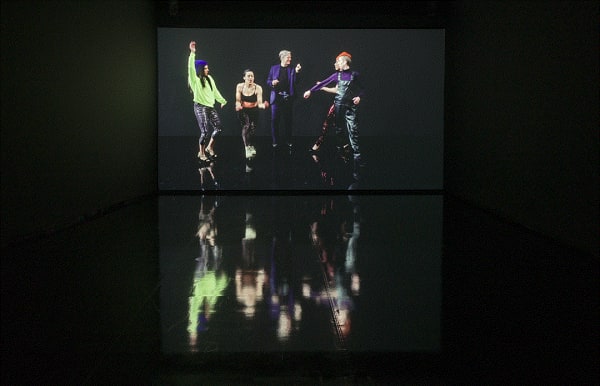Can moving arms, legs and hair be inspiring for a movement, a coming uprising for more joyful and equal ways of living together? Engaged with the precarious moment of taking the stage—a moment which allows for one’s visibility while at the same time disclosing one’s fragility—Portrait of a Movement addresses questions of pleasure, power, and radical difference. Portrait of a Movement is the first solo exhibition in Sweden of the internationally-renowned artist duo Pauline Boudry / Renate Lorenz.
Two large film installations form the core of the exhibition: while engaging with dance movements and artistic collaborations, they explore abstraction’s potential for resistance in the face of reactionary politics.Portrait of a Movement is the first exhibition-based outcome of a decade-long artistic conversation with Boudry / Lorenz and the curator Övül Ö. Durmusoglu. The Stockholm edition of the exhibition is based on the dense, sensual dialogue between (No) Time (2020) and Moving Backwards (2019) reflected on the black, glossy dancefloor that is already traced by the visitors of former exhibitions. The films are accompanied by the special shoes dancers used in Moving Backwards, first shown in the Swiss Pavilion of 58th International Biennial in Venice. The film installation (No) Time (2020) was co-commissioned by Ca2M, FRAC Brétagne and Seoul Mediacity Biennial, and produced for the exhibition at Ca2M in Madrid during the pandemic alongside Stages (Spektor Books, 2022), the first retrospective publication looking at the fifteen years of Boudry / Lorenz collaboration through different objects and situations.
In the installation (No) Time, four performers seem to be rehearsing for a queer time, employing strategies such as extreme slowness, being out of synch, changes of rhythm, stillness, and breaks as they work on escape routes, refusing the deadening beats of labor and the state-sponsored hopeless tacts of being. Both the film set and the installation employ automated elements—a sliding door and a set of blinds mimic the camera’s shutter while offering some refuge in the face of the camera’s gaze. Also activated by the feeling of being pushed backwards by recent backlashes, the second large installation, Moving Backwards, explores resistance practices, combining choreography and urban dance with guerrilla tactics and elements of queer underground culture. Captured by a relentlessly-moving camera, parts of the walks, solos, and group dances are carried out backwards, while others are digitally reversed, giving way to doubt and ambiguity in the installation as a whole. As you follow the performers’ movements, you might no longer understand if they are walking forwards or backwards, if they are moving towards their future or their past.





